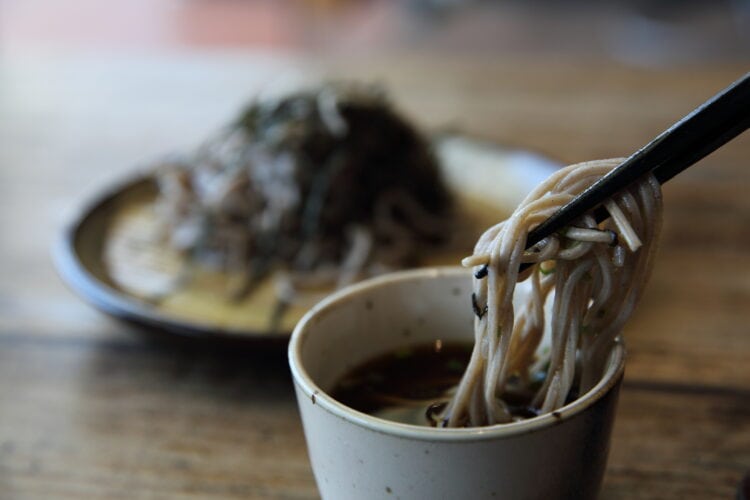What is zaru soba?
Zaru soba, also known as mori soba, is a refreshing, delicious buckwheat noodle dish, especially prized during the hot, humid summers in Japan.
Served cold, it’s the perfect way to cool down during a heatwave. Many people in Japan say that zaru soba is one of the best ways to fully appreciate the flavor and texture of soba noodles.
The name “zaru soba” refers to the traditional way it’s served. “Zaru” is a bamboo sieve used in Japanese cooking, and the noodles are traditionally served on this sieve, allowing excess water to drain.
This enhances the presentation and helps keep the noodles at their best texture.
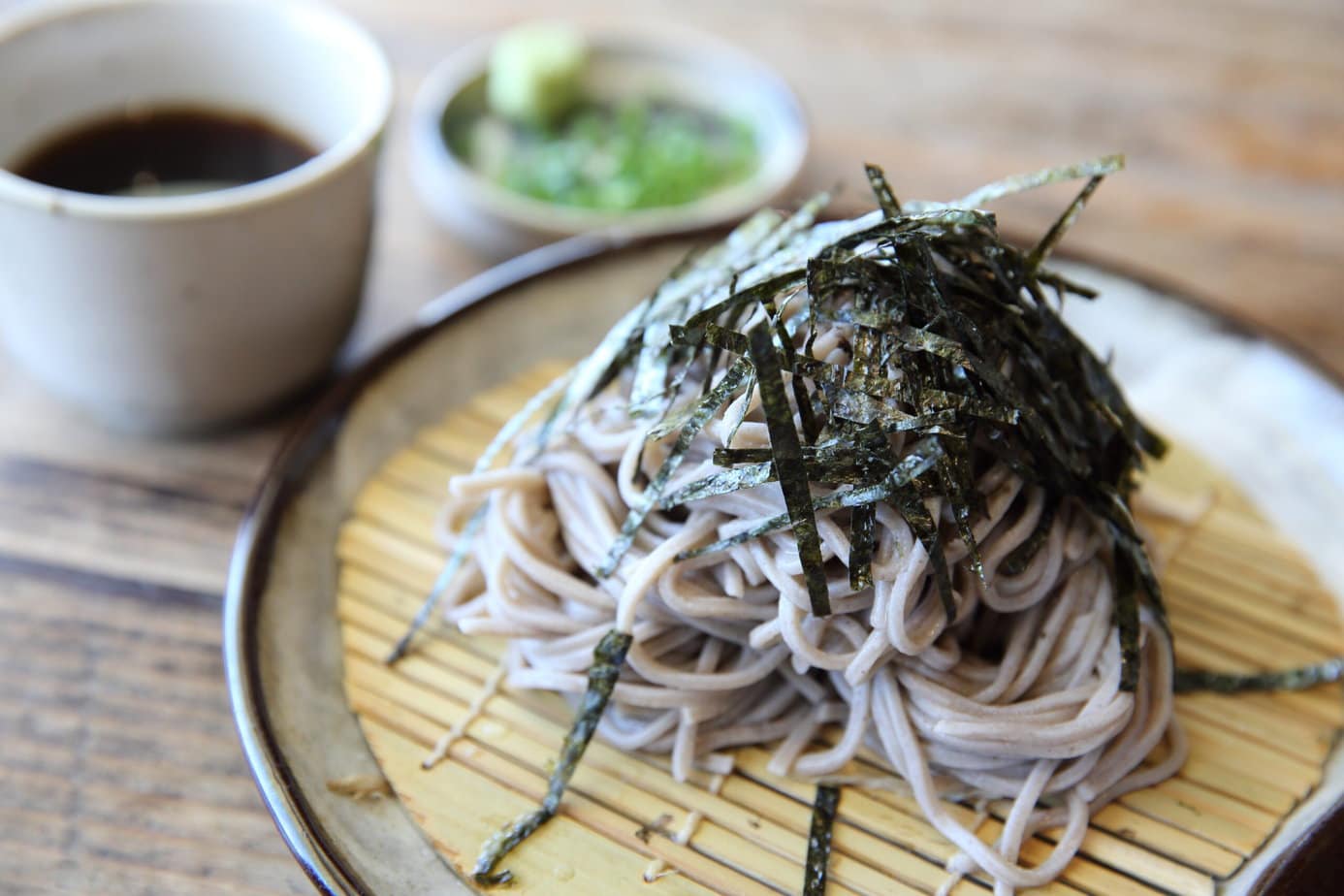
Soba is served with a savory dipping sauce called tsuyu (or mentsuyu). Dip the noodles just before eating. The sauce is rich in umami and is traditionally made from a blend of sake, mirin, soy sauce, dried bonito flakes, and kombu seaweed. Here’s the mentsuyu recipe
Whether in the height of summer or during the shoulder seasons, zaru soba is a staple of Japanese cuisine, offering a refreshing mix of flavors and textures that delights lovers of noodles and light, fresh dishes.
How do you eat zaru soba?
To boost the sauce’s flavor, add finely sliced green onions and a dab of wasabi to taste.
When serving, the noodles are often topped with thin strips of nori (dried seaweed), adding another layer of texture and flavor.
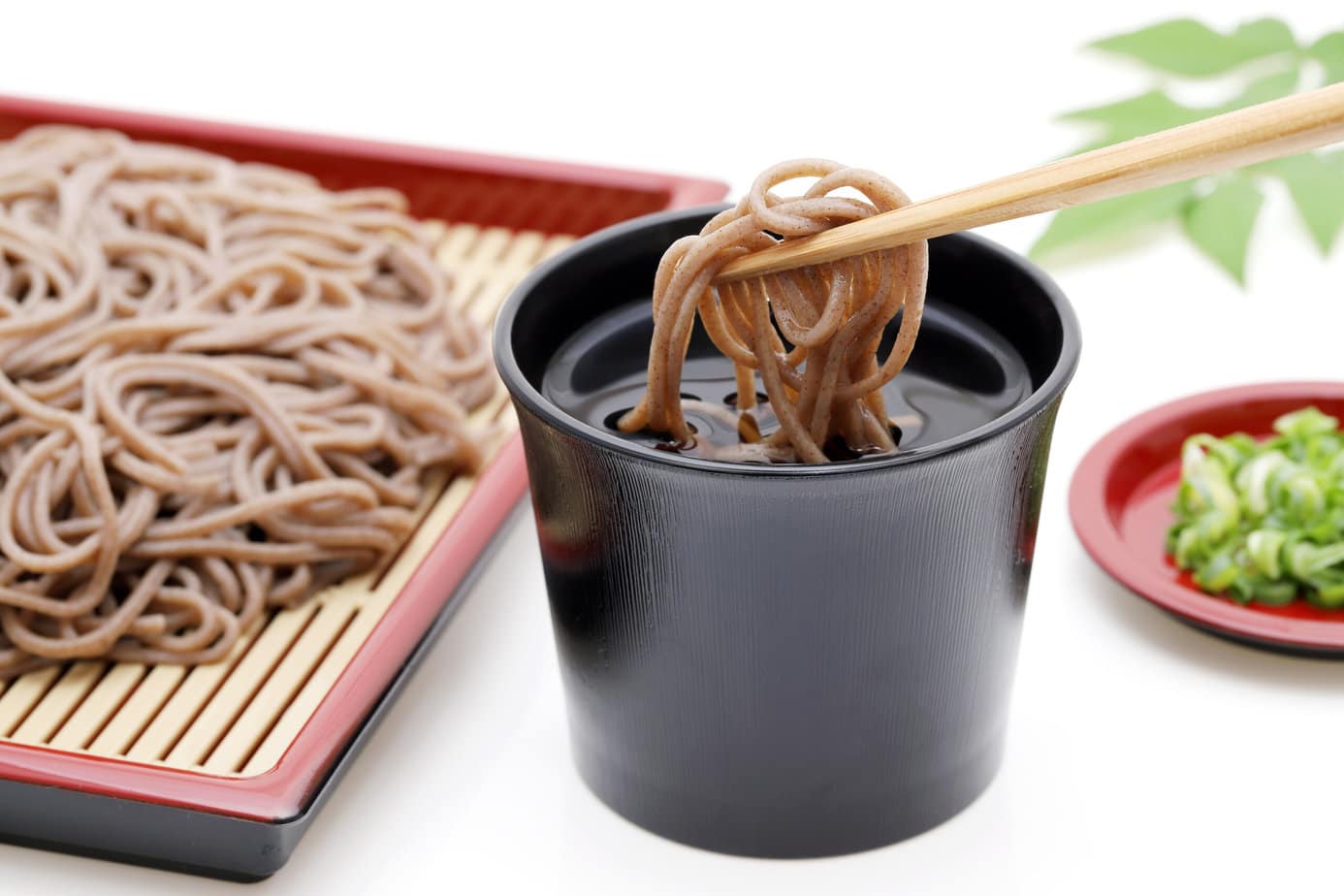
Beyond enjoying it on its own, zaru soba is often served as part of a set alongside tempura and other small dishes, making the meal even more satisfying and balanced.
Why is the sauce served separately from the noodles?
Soba noodles lose their “al dente” texture quickly, so to preserve that firmness they’re rinsed in cold water and kept “dry” until it’s time to eat.
Of course, soba is also eaten hot in broth. Still, no time to waste there either! It doesn’t like to play diva in a bouillon jacuzzi and prefers to be devoured without delay. The Japanese, experts in the art of soba, cheer you on with a lively “Soba nobiru yo!” – “Your soba will stretch!” In short, don’t let it linger too long in the sauce or you risk losing that beloved snap!
The main ingredients of zaru soba
This section is short, since I detail the toppings just below.
Because yes, apart from the mentsuyu and the soba… it’s all about the toppings!
Possible toppings for zaru soba
Nori – Good-quality nori is packed with umami. It’s usually cut into thin strips with scissors to serve with soba, but you can also tear it into small pieces with your hands.
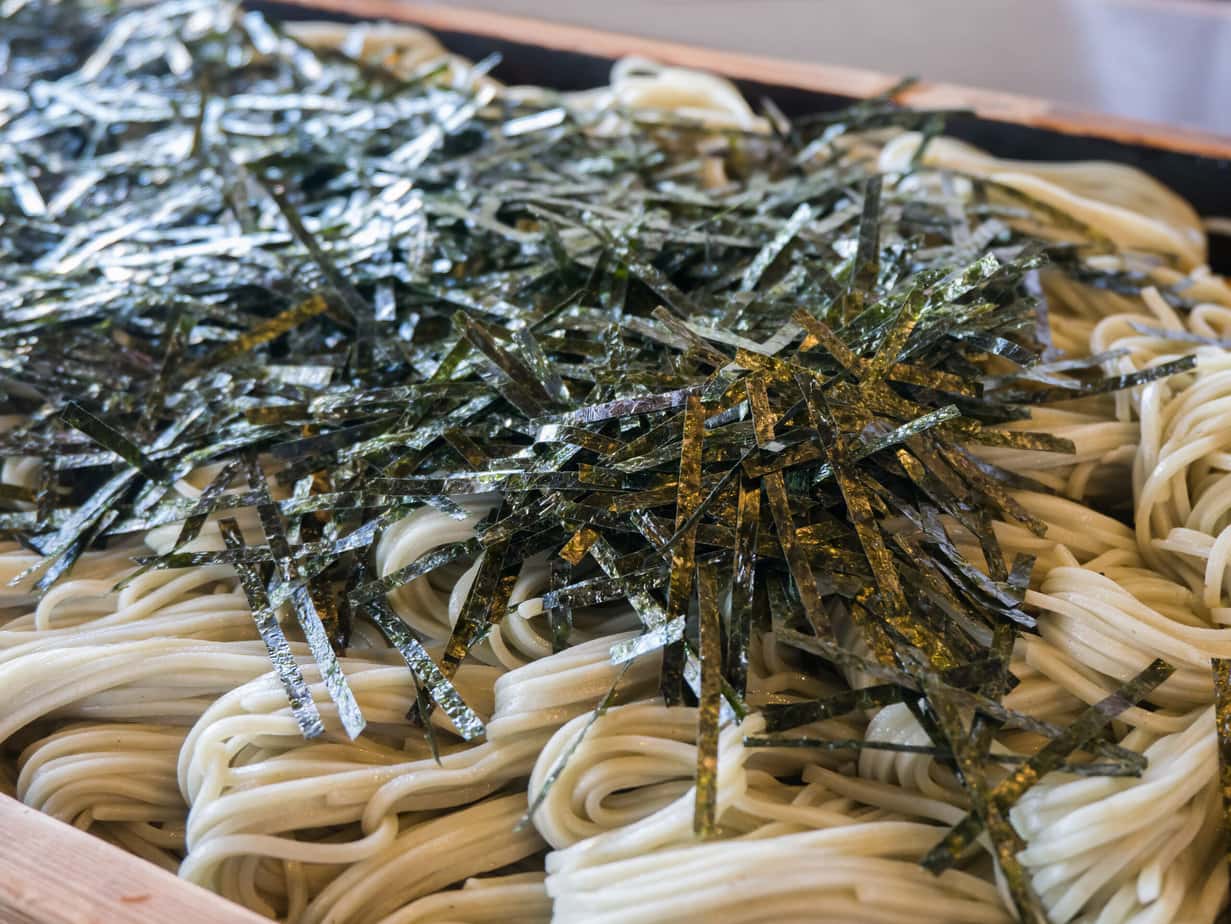
Green onions (scallions) – In Japan, there are several varieties of green onions, and a very thin type called “bannou negi” is most commonly used as a condiment for soba. If you can’t find thin green onions, substitute chives, or finely slice a larger scallion.
Wasabi – Wasabi adds a pleasant kick of heat to the dipping sauce. It’s best freshly grated, but if you can’t find fresh, tube wasabi works too (many are made from wasabi stems and leaves—check the label).
I don’t recommend the powdered kind, which is usually made from horseradish and mustard with coloring to mimic real wasabi.
Daikon oroshi (grated daikon) – Grated daikon is a common condiment for the dipping sauce, as the fine pulp absorbs the sauce and clings to the noodles.
When I grate daikon, I like to use the top half (leaf end) because it tends to be milder and less spicy. The bottom half (root end) works better for cooked dishes.
Other toppings – Aromatics such as ginger, myoga, zest of yuzu, shiso, and sesame seeds are all great options. You can also add ingredients to change the texture, such as a raw quail egg, chopped okra, or grated yamaimo.
These days, soba noodles are often turned into a soba salad by tossing them with vegetables and protein, then serving with a light dressing.
Tips for making perfect zaru soba
For a convenient shortcut, make the sauce with instant dashi stock, available in powder or infusible sachets at Asian grocers (replacing the katsuobushi and kombu in the sauce).
To achieve the ideal texture for cold soba, use a two-step cooling process. First rinse off the starch and bring the noodles to room temperature. Then plunge them into ice water to chill thoroughly.
Save the soba cooking water and you can turn any leftover dipping sauce into a small, comforting soup to end the meal on a cozy note. This is called soba yu.
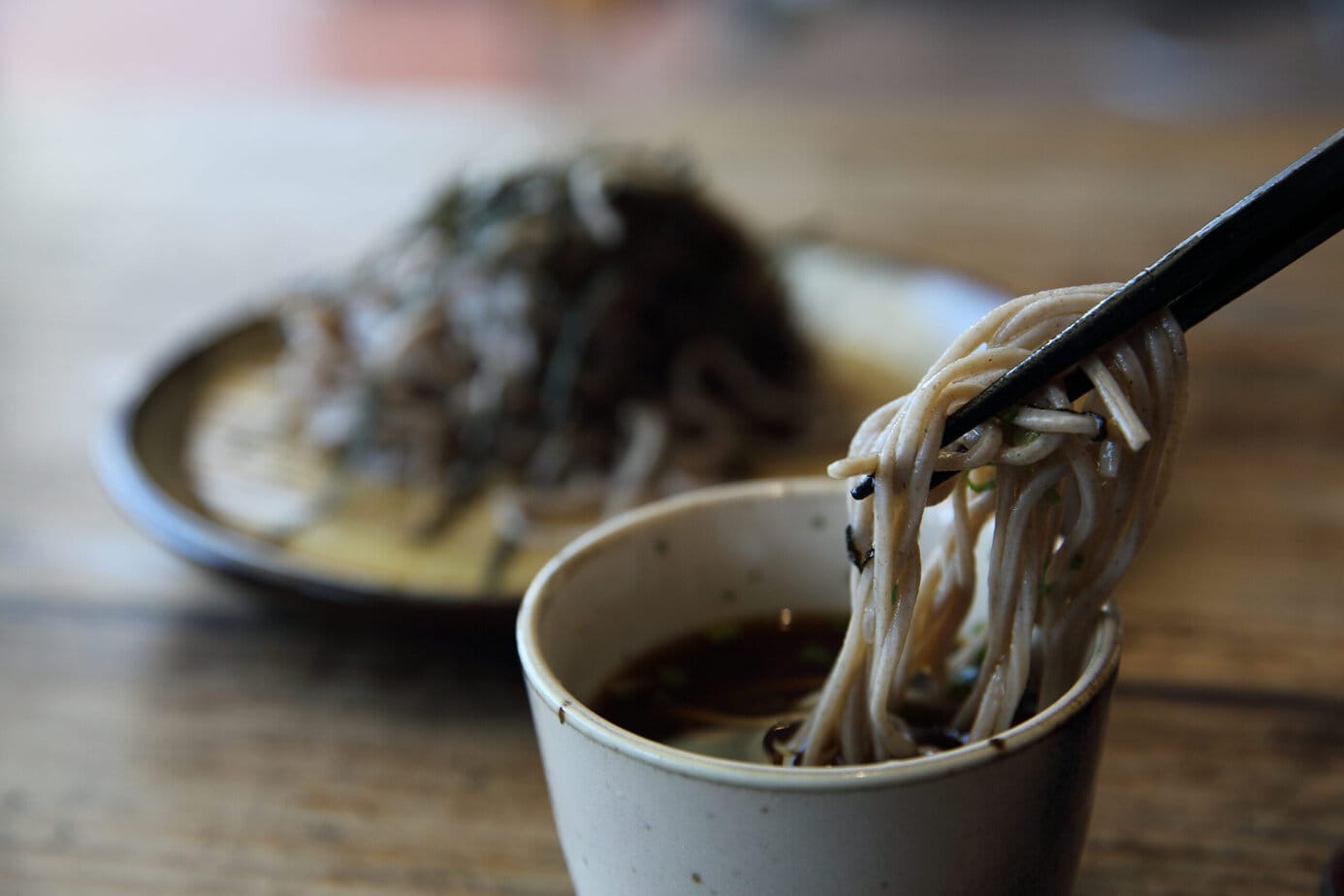
Equipment
Ingredients
- 200 g dried soba noodles
- 45 ml mentsuyu click for the recipe
- 135 ml ice water
Toppings
- 1 green onion, thinly sliced
- shredded nori seaweed
- wasabi optional
Instructions
To cook the soba
- Bring plenty of water to a boil in a large pot. Unlike pasta, do not add salt to the cooking water.
- Add the dried soba noodles to the boiling water, spreading them around the pot in a circular pattern to keep them separate.200 g dried soba noodles
- Cook the soba noodles according to the package instructions. Stir occasionally so they don’t stick together.
- The noodles are ready when just tender; do not overcook. Before draining, reserve a large bowl of the cooking water called “sobayu” to mix with any leftover dipping sauce at the end of the meal.
- Drain the soba noodles in a colander and rinse under cold running water to remove excess starch. This is a very important step to prevent the noodles from sticking together.
- Shake the colander to drain completely. Transfer the noodles to a large bowl of ice water. Chill for 30 seconds, drain well, and set aside.135 ml ice water
To serve the Zaru Soba
- To serve, place sieves or bamboo mats on individual plates (to catch any dripping water). Arrange a portion of soba on each mat and top with shredded nori.shredded nori seaweed
- Use about a 1:3 ratio of mentsuyu to water—for example, combine 45 ml mentsuyu with 135 ml ice water—and taste to adjust. If it’s too salty, add more water; if it’s too diluted, add more mentsuyu.45 ml mentsuyu
- Place the green onion and wasabi in small individual dishes and serve alongside the soba with small bowls for dipping.1 green onion, thinly sliced, wasabi
